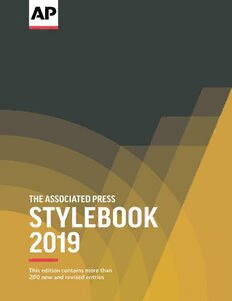
2019 AP STYLEBOOK (Spiral-Bound) PDF
Preview 2019 AP STYLEBOOK (Spiral-Bound)
Contents Foreword What’s new Key to Stylebook entries A | B | C | D | E | F | G | H | I | J | K | L | M | N | O | P | Q | R | S | T | U | V | W | XYZ Punctuation Business Covering Corporate Earnings Reports International Bureaus Bankruptcy Mergers and Acquisitions Data journalism Polls and surveys Health and science AP social media guidelines The Basics Using Lists to Stay Organized And Protect Your Privacy Search for People — and Their Photos and Videos User-Generated Content Digital Security for Journalists Social Media Guidelines for AP Employees Religion Religion Guidelines Sports Sports Identification Codes Major College Basketball Conferences Major College Football Conferences Football Championship Subdivision Food Fashion Briefing on Media Law Introduction Legal Principles of Newsgathering Legal Principles of Publication The Associated Press statement of news values and principles Corrections Data Fabrications Graphics and Interactives Images Music Obscenities, Profanities, Vulgarities, Hate and Propaganda Privacy of Victims Quotations Responses Social Networks Use of Others’ Material Broadcast Guidelines Corrections, correctives, clarifications Editing marks Bibliography About the AP Index Choose the right tool to keep you in style Foreword The first Associated Press Stylebook was 60 pages, bound together with staples, a basic guide for news writing. It has evolved into a comprehensive reference manual that fills more than 600 pages and is published across an array of digital platforms, encompassing the collective wisdom of the AP staff and Stylebook readers. Despite drastic changes in the media landscape, one constant remains: The AP Stylebook is a definitive resource for writers. Today's Stylebook still outlines basic rules on grammar, punctuation, usage and journalistic style, but it also reflects changes in common language, offers guidance on media law, explains AP's news values and principles, and helps to navigate the ever-changing world of social media. A team of top AP editors meets throughout the year to make updates and improvements, many of which appear immediately in Stylebook Online. Contributions come from the AP staff, AP's member news organizations and subscribers, journalism teachers and students, specialists in a host of fields, and everyday readers. Indeed, some of the changes that are talked about most have come at the suggestion of @APStylebook's Twitter followers. Every update is deeply rooted in respect for language and commitment to the original goal: to be clear, fair and concise around the globe, no matter what the news is or where it happens. Whether you access it in print or online, The Associated Press Stylebook remains an essential tool in newsrooms, classrooms and boardrooms alike, the perfect resource for journalists and anyone who cares about good writing. Gary Pruitt President and Chief Executive Officer What’s new In this edition of the AP Stylebook This edition of the Stylebook contains more than 200 new and modified entries. A new health and science chapter provides guidelines and flags pitfalls. Individual terms, including a new entry on “Medicare for All,” remain in the book’s main section. We added a race-related coverage entry, which begins: “Reporting and writing about issues involving race calls for thoughtful consideration, precise language, and an openness to discussions with others of diverse backgrounds about how to frame coverage or what language is most appropriate, accurate and fair.” The entry discusses the terms racist and racially charged, as well as blacks, Native Americans and more. We removed the hyphen from African American and other dual heritage terms. We now use the % symbol in all but casual uses: 53% of Americans, but he has a zero percent chance. We also now use accent marks and other diacritical marks in the names of people who request them. New entries discuss cryptocurrency; deepfakes; constitutional amendments and clauses; sports betting terms; vaping terms; and use of the words suspect, casualties, and human trafficking/human smuggling. We expanded our suicide entry and revised marijuana, medical marijuana; The Church of Jesus Christ of Latter-day Saints; and “right to work.” An enhanced hyphen section of the Punctuation chapter stresses: “If the sheer number of hyphens in a phrase, or confusion about how to use them, can daunt either the writer or the reader, try rephrasing. It’s a guide about how to use hyphens wisely, not it’s a how-to-use-hyphens-wisely guide.” We no longer hyphenate most compound modifiers after versions of the verb to be. And: no hyphen in first grader, first quarter score, etc. We removed the hyphen in double-e combinations (reelection, preempt), reflecting usage. We also removed the hyphen from passerby and bestseller. We revised our guidance to say data typically takes singular verbs and pronouns in writing for general audiences. Also: Do not use the term sic to indicate incorrect spelling or usage. We now say that splitting the infinitive or compound forms of a verb is often necessary to convey meaning and make a sentence easy to read. We added more guidance to the headlines entry. The composition titles entry is rewritten for clarity, and we removed quotation marks from game titles. We say STEM is acceptable on first reference. Grassroots is now one word, as is babysit and budtender. Macao is now our style, instead of Macau. We now use Ecuadorian instead of Ecuadorean. Macedonia is now North Macedonia. We note that it’s frosting or icing, depending on where you live. And: Santa Claus, Santa Nice in any reference. Naughty: Using Claus on second reference. Mrs. Claus is acceptable for Santa’s wife. Key to Stylebook entries This updated and revised version of The Associated Press Stylebook has been organized like a dictionary. Need the acronym for a government agency? Look under the agency’s name. Should you capitalize a word? Check the word itself or the capitalization entry. What’s the format for baseball boxes? See baseball. A key to entries is on the next screen. Tap image to enlarge
